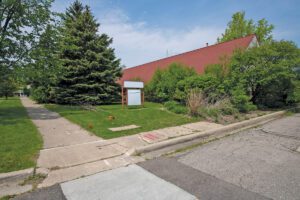In 2015, the city set a goal of creating 140 units of affordable housing each year, but so far there has been a net increase of only 195 units. City council’s attempt to force developers to include more subsidized housing in student high-rises failed (see “Going Up,” April), and the first projects financed by the 2020 affordable housing millage are still in the planning process.
“It is going to be multiple entities, both for profit and nonprofit, that will end up building all of the affordable housing that’s needed,” says Jennifer Hall, executive director of the Ann Arbor Housing Commission.

“The developer was planning on building affordable housing on Commerce Dr. for many years, and the developer before that, and the developer before that, and they were not able to make the numbers work,” says Jennifer Hall of the former SelectRide property. “Hopefully the project will now be financially feasible to build.”
So Hall is encouraged at the news that Indiana-based workforce housing developer The Annex Group is in talks with the city about building an affordable 252-unit apartment complex on Commerce Dr. If it goes ahead, “The Union at A2” will target residents who earn an average of 60 percent of the county’s area median income (AMI).
The impetus was city council’s February vote to rewrite the city’s PILOT (payment in lieu of taxes) program. Councilmembers raised the income limit for eligible projects from 60 to 80 percent of AMI—and then approved a PILOT for the Commerce Dr. project that will forgo taxes as long as residents’ income averages no more than 60 percent.
It’s a subtle but significant distinction. With a 60 percent cap, every resident earning less would reduce the average income. With an 80 percent cap, managers can balance residents earning less with others earning more. Tyler Knox, Annex’s development manager for the project, says he believes the change “will create a better environment for the production of affordable housing in Ann Arbor.”
In April, Annex was looking at dedicating 16.4 percent of the units in the Commerce Dr. project to households with incomes up to 30 percent of AMI. Another 2.8 percent could have incomes up to 50 percent of AMI, 54.8 percent 60 percent, and 26 percent could be up to 80 percent AMI.
The company also is seeking low-income housing tax credits through the Michigan State Housing Development Authority; if they’re approved, the building would remain affordable for the thirty-five year duration of the credits and then become market-rate. As long as the project remained affordable, its PILOT payment to the city would be just $1 per unit per year.
The site behind the Stadium post office, formerly SelectRide’s headquarters, has been vacant since Uber and Lyft drove the cab-and-limo company out of business in 2015. “The developer was planning on building affordable housing on Commerce Dr. for many years, and the developer before that, and the developer before that, and they were not able to make the numbers work,” says Hall. “Hopefully the project will now be financially feasible to build.”
Along with the rest of the business district along W. Stadium and Maple, the site was rezoned last year: it’s the city’s second “transit corridor” zone, after the area around Briarwood. But though the “TC1” zoning has no height limit, Annex’s plan is just four stories.
Knox points out that the site plan they inherited for the location was approved “prior to the rezone to TC1,” but adds that height also affects affordability: “There are increased construction costs when constructing a building higher than what is currently proposed.”
According to Hall, all construction costs have risen 50 percent since the pandemic. Knox allows that the project is still fluid. “It’s important to note that right now we’re only in the proposal stage, and plans can change.”
Developers are continuing to request approval for high-rises near Central Campus (“Going Up,” April), but none have yet been proposed in either of the TC1 zones. Planning manager Brett Lenart says there have been some inquiries, but he’s not surprised people are taking their time:
“I always say these corridors got to this condition over a long period of history, and transforming them is going to take a long time as well.”